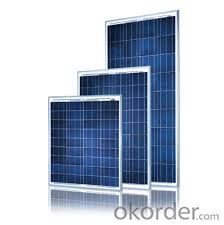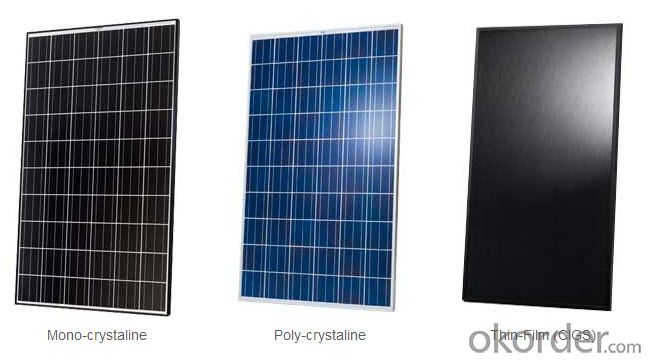240W Poly solar Panel with 25 Years Warranty CNBM
- Loading Port:
- Qingdao
- Payment Terms:
- TT OR LC
- Min Order Qty:
- 10 set
- Supply Capability:
- 300000 set/month
OKorder Service Pledge
OKorder Financial Service
You Might Also Like
Polycrystalline Solar Modules
CNBM offers a range of small, medium and large polycrystalline solar modules, designed for a range of requirements.


Specifications:
Tolerance | +/-3% |
Cell | Polycrystalline silicon solar cells (156 x 156mm) |
N0. of Cells | 60 (10 x 6) |
Dimension of Modules (mm) | 1650 x 990 x 40 |
Weight (kg) | 25.5 |
Limits:
Operating Temperature | -40~+85? |
Storage Temperature | -40~+85? |
Maximum System Voltage | 1000 VDC max. |
Hail Impact | Diameter of 28mm with impact speed |
Temperature and Coefficients:
NOCT | 48C+/-2? |
Voltage temperature coefficient (%/K) | -0.35 |
Current temperature coefficient (%/K) | 0.05 |
Power temperature coefficient (%/K) | -0.45 |
Characteristics:
Model: | SGM-200P | SGM-210P | SGM-220P |
Max-power voltage Vmp (V) | 29.2 | 29.4 | 29.41 |
Max-power current Imp (A) | 6.85 | 7.14 | 7.48 |
Open-circuit voltage Voc (V) | 36.5 | 36.69 | 36.9 |
Short-Circuit Current Isc (A) | 7.28 | 7.6 | 7.93 |
Max-power Pm(W) | 200 | 210 | 220 |
Model: | SGM-230P |
Max-power voltage Vmp (V) | 29.8 |
Max-power current Imp (A) | 7.72 |
Open-circuit voltage Voc (V) | 37.31 |
Short-Circuit Current Isc (A) | 8.19 |
Max-power Pm(W) | 230 |
STC: Irradiance 1000W/m2, module temperature 25?, AM-=1.5
Poly Crystalline Solar Panels Specifications Range
Maximum Power (Pm) | Dimension | Weight | Operating Voltage (Vmp) | Operating Current (Imp) | Open Circuit Voltage (Voc) | Short Circuit Current (Isc) |
0.45W | 140x80x10mm | 0.08kg | 3.3V | 150mA | 4.6V | 160mA |
1.0W | 162x140x10mm | 0.16kg | 7.5V | 150mA | 10.3V | 160mA |
4.5W | 269x251x23mm | 0.8kg | 16.5V | 0.27A | 20.5V | 0.3A |
10W | 420.1×268.9×22.6mm | 1.92kg | 17.5V | 0.58A | 20.5V | 0.6A |
20W | 425x502x50mm | 3.0kg | 16.8V | 1.19A | 21.0V | 1.29A |
30W | 593x502x22.6mm | 3.9kg | 16.8V | 1.78A | 21.0V | 1.94A |
40W | 655x537x50mm | 5.75kg | 17.3V | 2.31A | 22.1V | 2.54A |
50W | 839x537x50mm | 6.0kg | 17.5V | 2.9A | 21.8V | 3.17A |
65W | 1111x502x50mm | 7.2kg | 17.6V | 3.69A | 22.1V | 3.99A |
80W | 1204x537x50mm | 7.7kg | 17.6V | 4.55A | 22.1V | 4.8A |
- Q:Can solar cells be used to charge batteries?
- Yes, solar cells can indeed be used to charge batteries. Solar cells convert sunlight into electricity, which can then be used to charge batteries and store energy for later use. This is a common application of solar energy, especially in off-grid and remote areas where access to the grid is limited or unavailable.
- Q:Can solar cells be used to power an entire household?
- Yes, solar cells can be used to power an entire household. With advancements in solar technology and proper installation, a solar power system can generate enough electricity to meet the energy needs of a household, especially when combined with energy storage solutions. However, the feasibility and effectiveness of using solar cells to power an entire household depend on various factors such as the size of the solar system, energy consumption patterns, geographic location, and available sunlight.
- Q:What is the effect of wind on solar cell performance?
- The effect of wind on solar cell performance can be both positive and negative. On one hand, wind can help cool the solar cells, preventing overheating and improving their overall efficiency. Additionally, wind can help clean the surface of the solar panels, removing dust and debris that may obstruct sunlight and reduce energy production. On the other hand, strong winds can create vibrations and mechanical stress on the solar panels, potentially damaging their structure or causing misalignment. Therefore, while some wind is beneficial for solar cell performance, excessive or turbulent wind conditions may have a detrimental impact.
- Q:Can solar cells be used on satellites?
- Yes, solar cells can be used on satellites. In fact, they are commonly used as the primary source of power for satellites in space.
- Q:Can solar cells be used in emergency lighting?
- Yes, solar cells can be used in emergency lighting. Solar cells are capable of converting sunlight into electrical energy, which can be stored in batteries for later use. This makes them a reliable and sustainable option for emergency lighting, as they can provide power during power outages or in remote areas where traditional electricity sources may not be available.
- Q:How do solar cells perform in desert environments?
- Solar cells perform exceptionally well in desert environments due to the abundance of sunlight and high temperatures. The vast open spaces and lack of cloud cover allow solar panels to receive maximum exposure to sunlight, resulting in higher energy production. Additionally, the dry and arid conditions in deserts help reduce dust and dirt accumulation on panels, ensuring optimal performance and efficiency.
- Q:What is the impact of bird droppings or debris on solar cell performance?
- Bird droppings or debris on solar cell surfaces can significantly impact their performance. The accumulation of bird droppings or debris on the surface of solar cells can block sunlight from reaching the cell, reducing the amount of energy the cell can generate. This obstruction can lead to a decrease in the overall efficiency of the solar panel. Additionally, bird droppings contain corrosive substances that can damage the protective coatings on the solar cells, potentially reducing their lifespan. Therefore, regular cleaning and maintenance of solar panels is essential to ensure optimal performance and maximize energy production.
- Q:Can solar cells be used in electric fence systems?
- Yes, solar cells can be used in electric fence systems. Solar panels can generate electricity from sunlight, which can then be stored in batteries and used to power electric fences. This eliminates the need for a connection to the main power grid and makes electric fence systems more flexible and cost-effective in remote areas.
- Q:Can solar cells be used to charge electric vehicles?
- Yes, solar cells can be used to charge electric vehicles. Solar panels can convert sunlight into electricity, which can then be used to charge the batteries of electric vehicles. This allows for sustainable and renewable energy sources to power electric vehicles, reducing reliance on fossil fuels and decreasing carbon emissions.
- Q:What is the role of bypass diodes in solar cell arrays?
- The role of bypass diodes in solar cell arrays is to minimize the impact of shading or partial shading on the overall performance of the array. They provide an alternative path for the current to flow, allowing the unaffected cells to continue producing electricity while the shaded cells are bypassed. This prevents the shaded cells from acting as a resistor and reduces the risk of hotspots or damage to the cells.
1. Manufacturer Overview |
|
|---|---|
| Location | |
| Year Established | |
| Annual Output Value | |
| Main Markets | |
| Company Certifications | |
2. Manufacturer Certificates |
|
|---|---|
| a) Certification Name | |
| Range | |
| Reference | |
| Validity Period | |
3. Manufacturer Capability |
|
|---|---|
| a)Trade Capacity | |
| Nearest Port | |
| Export Percentage | |
| No.of Employees in Trade Department | |
| Language Spoken: | |
| b)Factory Information | |
| Factory Size: | |
| No. of Production Lines | |
| Contract Manufacturing | |
| Product Price Range | |
Send your message to us
240W Poly solar Panel with 25 Years Warranty CNBM
- Loading Port:
- Qingdao
- Payment Terms:
- TT OR LC
- Min Order Qty:
- 10 set
- Supply Capability:
- 300000 set/month
OKorder Service Pledge
OKorder Financial Service
Similar products
New products
Hot products
Related keywords



























